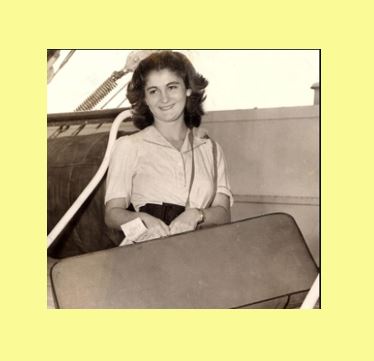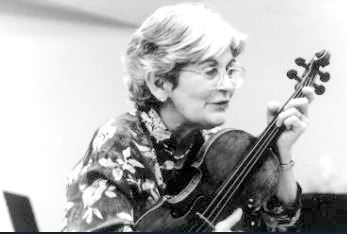



PHOTOGRAPHS
The Tiny Prodogy
On Tour
Teaching – 1
Teaching -2
A brief description of each page on this site is given below.
KATO HAVAS – displays a brief biography of The New Approach’s creator.
NEW APPROACH – displays a brief outline of The New Approach and its achievements.
KHANA – lists the KHANA representatives around the world.
SOURCES – lists where books, videos, etc. on the New Approach may be obtained.
CALENDAR – lists coming KHANA courses and seminars around the world.
MESSAGE BOARD – a place for questions and comments about The New Approach.


Kató Havas OBE
5 November 1920 – 31 December 2018
The life and work of Kató Havas was unique. As a teacher, her contribution to music in general, and for the string player in particular, was, and is, unprecedented. Her message was to discover the full power of music through the release of tension in mind and body, thus allowing its full force to be communicated.
Hungarian born in the small Transylvanian town of Keszdivasarhely on 5 November 1920, she was a child prodigy of the violin. Introduced to the instrument at the age of 5, she gave her first professional recital when she was 7. Her compatriot, Emil Telmanyi, was so impressed by her playing that he arranged for her to go to Budapest at the age of 8 to study with Imre Waldbauer at the Franz Liszt Academy. There she received the traditional virtuoso training. Waldbauer (the first violin of the first Hungarian Quartet) took the young Kató under his wing, and was responsible for sowing the seeds of what was later to become the ‘New Approach to Violin Playing’.
At the age of 18 Kató went on a short concert tour of the USA, and on 10 October 1939 she made her debut at Carnegie Hall to great critical acclaim. She then met and married the author, William Woods, and was unable to return to Hungary for more than thirty years because of the war and the subsequent Russian occupation.
With three small daughters to care for, she put public performance on one side, and it was during this period that what was to become the ‘New Approach’ was germinating in her mind. She sought out the violinist David Mendoza, who understood the true function of the left hand in relation to the right arm, which was to forge the last link in the chain for her holistic approach to string playing.
In the 1950s, now living in the South of England, she began to put her approach into practice by writing her first book, A New Approach to Violin Playing (published by Bosworth), running summer courses for string players, and founding the Purbeck Festival of Music. Kató later went on to write the definitive Stage Fright: its causes and cures, The Twelve Lesson Course and the autobiographical The Violin and I, all of which have been reprinted many times, and translated into many languages including Chinese, German, Spanish, Swedish, Czech, Hungarian, Japanese, Italian and Dutch.
A facet of her teaching was that she would accept anybody as a pupil, whether a complete beginner or a concert soloist, and was able to give each person what he or she needed. Whether she was in a one-to-one situation or at a workshop comprising 20 or 30 people, her communication was all-pervasive, and her charisma all-embracing. It was said that within the first few minutes after she had walked into the room at a workshop, she could assess the violinistic problems of most of the people there.
Because Kató Havas worked entirely alone, and eschewed being associated with any music institution, the ‘Establishment’ in Britain (of which she had become a citizen) could be rather cool, if not positively hostile, to her approach, despite her regular and well-attended workshops in the Lake District, in London and in Oxford and the International Music Festivals she founded and directed in Purbeck, Roehampton and Oxford. However, Yehudi Menuhin, did understand and recognize her contribution to string playing, and endorsed her work in a very positive way
While recognition might have initially been slow in her own country, before long she was being invited to lecture extensively around the world where her ideas were accepted enthusiastically in such countries as Australia, New Zealand, Canada and many European countries. She lectured regularly in the United States, returning annually to California and New England for very popular workshops. At her Oxford studio in England, where she was based, she was approached by and worked with players from all over the world.
In 1985 Kató’s pupils worldwide formed themselves into ‘The Kató Havas Association for the New Approach (KHANA)’. In 1991 she made a teaching video in which she was able to demonstrate the principles of the New Approach in less than an hour – at the age of 71, one of her best solo performances! In September 2002, the wheel having come full circle, she was invited to return to Hungary to lecture to a packed hall of musicians and teachers of the Academy where she had studied as a young girl.
Kató kept her personal life entirely separate from her career, and had many interests apart from music. She was an avid and eclectic reader, took a great interest in the visual arts, and had a passion for the art and literature of Classical Greece. She travelled widely with her husband, well into old age, seeking places of cultural interest which could also offer the sunshine she so missed, living in England.
It was in 1990 that Kató received the International Award from the American String Teachers’ Association for her “unparalleled achievements” and in 2002 she was awarded the OBE by the Queen for services to music. This was presented to her at Buckingham Palace on 10 October, the anniversary of her debut at Carnegie Hall more than sixty years before. In 2013 she received the Lifetime Achievement Award from the British branch of the European String Teachers’ Association “in celebration of a lifetime’s contribution to string teaching.” She continued to teach into her 90s, giving her last Summer Workshop at the University of Oxford, St Edmund Hall at the age of 90 and her last Informal KHANA Workshop at the age of 96. She died on 31 December 2018 aged of 98.
Kató Havas was one of those very rare people who understood the true nature and power of music, and was able to show how to nurture the ‘inner pulse’ and ‘inner voice’, and how to free the mind and body by putting everything in balanced order, allowing the music to speak freely through the instrument – the ideal musical communication. Should all this be manifest to the degree required, the most negative and terrifying aspect of music-making, ‘stage fright’, will have no room to flourish. What greater gift could a musician receive?
Music has lost one of its great champions, but is the richer for her life and work.
6 and 12 Lesson Courses on the Havas New Approach are available with Personal Representative Teacher Gloria Bakhshayesh, 3 Beacon View, Marple, Stockport, SK6 6PX, England. gloria.khana@gmail.com
For Representatives around the world, please see the KHANA page of this site.


